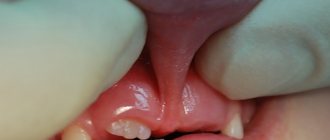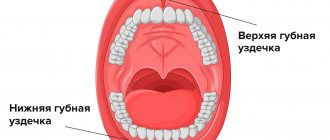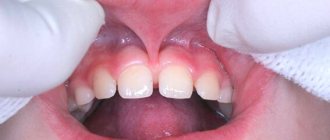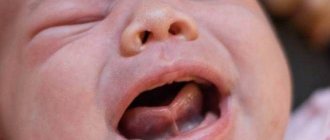Unnoticeable at first glance, anatomical formations located in the oral cavity (frenulum) can affect a child’s ability to attach to the breast in infancy, speech and bite, the purity of pronunciation of words and phrases, and the aesthetics of a smile.
Our clinic “White Whale” carries out timely diagnosis of oral health in children of any age using a specially developed technique. Parents who contact us for the first time often become regular clients. The result of cooperation with us is healthy children, satisfied parents.
Oral anatomy
There are three frenulums in the mouth. The most important and insidious is the frenulum of the tongue, attached from the underside of the tongue to the sublingual space. The frenulum of the upper lip is woven into the mucous membrane of the gums above the level of the anterior incisors. The frenulum of the lower lip has a connection similar to the upper one.
A shortened frenulum is diagnosed in infancy, in infants (usually this concerns the frenulum of the tongue). Abnormal development of the frenulum of the upper and lower lips is usually discovered in the dental chair or at an appointment with a speech therapist.
Description of the problem
The frenulum is a part of the oral mucosa that connects the gum to the middle of the inner surface of the upper or lower lips. Its function is to limit the movement of the lips and provide additional attachment to the jaw bones. The problem arises when the bridles are attached incorrectly or are not long enough.
Anomalies of the frenulum in children most often lead to difficulties with chewing and sucking, and disturbances in the development of speech function. For adults, problems are associated with increased tension on the edges of the gums. Gum pockets appear, gums begin to recede, and the bite becomes disturbed (with age, the procedure for correcting it becomes more difficult). A short frenulum of the upper lip provokes the development of excessive spaces between the front teeth. The anomaly contributes to the accumulation of food deposits under the lips and on the surface of the teeth.
Frenules in the oral cavity
When parents talk about the frenulum in the child’s mouth, most often they mean the frenulum of the baby’s tongue, which is quite natural. Problems arise more often precisely because of this oral frenulum: from improper attachment to the breast in the first days of life to speech impairment in the future.
Even dentists give the leading role and importance to this particular frenulum, but this does not mean that the remaining frenulums are unimportant and cannot provoke any pathology.
There are three frenulums in the child's mouth. A frenulum in the oral cavity is nothing more than a small strand of mucous membrane. But, despite this, the frenulum in the oral cavity is of great importance in the life of a child; the child’s nutrition, correct pronunciation of sounds, the condition of the mucous membranes, not to mention the child’s bite and facial aesthetics depend on their condition.
Dentists distinguish between the frenulum of the upper and lower lips and the frenulum of the tongue. Each of them has its own location and performs a number of functions. The frenulum of the lower lip connects the body of the lower jaw and the lower lip; normally, the frenulum is woven into the gum of the lower jaw below the level of the central incisors.
The frenulum of the upper jaw is located according to the same principle as the frenulum on the lower lip. This mucous cord also raises many questions and complaints from parents, since it is primarily associated with the formation of an aesthetic defect in the oral cavity - a gap between the teeth. And the last frenulum in the baby’s mouth is the lingual frenulum, which is woven into the tongue and sublingual space.
Content:
Lip frenuloplasty is a corrective operation to trim the fold that attaches the lip to the jaw. Lip frenuloplasty was first performed in the middle of the last century. But now this procedure can be performed using a laser. It is laser lip frenuloplasty that will be discussed later in this article.
If there is an incorrect structure of the frenulum, a person begins to experience problems from this even in childhood, and over time they gradually intensify. The development of malocclusion, predisposition to periodontal disease, problems with articulation - this is not all that a person with an irregular lip frenulum may encounter.
Laser lip frenuloplasty can not only make your smile more beautiful, but also correct various problems with speech or with the installation of orthopedic structures, which are often observed in patients with improperly developed labial frenulum.
Laser excision of the labial frenulum is performed without complex special preparation, and the entire operation takes place quite quickly, and the patient does not experience any significant inconvenience. Laser surgery for lip frenuloplasty is a modern and excellent method of correcting it.
Why are short bridles dangerous?
Short frenulum in the mouth can cause many unpleasant consequences. The first of them: the baby cannot attach to the breast correctly, so during feeding it expends a lot of effort, but at the same time receives a smaller volume of milk, and it is simply not enough to satiate. This is sometimes the reason for poor weight gain, but quite often mothers and doctors mistakenly look for the cause in a mythical lack of milk, or some disease, although, first of all, it is necessary to look into the oral cavity and assess the condition of the frenulum.
It is very important for parents to know and remember about this problem, because according to statistics, every 14th child has short frenulum in the oral cavity. If you notice this feature in time, then in the future you can avoid many problems and unpleasant consequences - disturbances in nutrition, speech, bite and, accordingly, facial aesthetics.
For the first time, doctors may notice a short frenulum in the baby’s mouth during the first examination, immediately after birth, and if the fact is confirmed, correction is carried out on the spot. This rule applies to a short frenulum of the tongue, but if the frenulum does not interfere with full natural feeding, the frenulum will not be trimmed in the maternity hospital. Symptoms of a short frenulum may appear later - the child may have difficulty pronouncing some sounds, in which case “treatment” will be carried out later, and, as a rule, in tandem with a speech therapist.
Causes of the defect
The anomaly occurs during intrauterine development. The provoking factors of a short frenulum of the tongue are:
- fetal infection;
- viral diseases that occur during the first and last trimester of pregnancy;
- genetic predisposition, heredity;
- unfavorable environmental background;
- abdominal injuries of a pregnant woman;
- chronic somatic diseases of the expectant mother.
The decisive factor is heredity. It was noted that among parents who personally encountered a similar pathology, their children often also needed frenulum correction.
Upper lip frenulum
Even with a simple smile you can see the frenulum of the upper lip, but few people pay attention to it. During a routine examination, the doctor assesses its length; in order to assess the size of the frenulum at home, parents just need to move the baby’s upper lip, and it will become noticeable where exactly the frenulum is woven. In the event that the frenulum is woven between the two front incisors 5–8 mm higher, this is a normal option. If the frenulum is woven below this level, these are obvious symptoms of a shortened frenulum, but the final word always remains with the doctor.
A short frenulum on the upper lip can provoke a violation of the aesthetics of a smile when a gap is formed between the central incisors - a trema, a diastema. It is worth remembering that tremors can be physiological; this period is observed during the period of primary occlusion, when the child’s jaws are preparing for the change of primary teeth to permanent ones. In addition, trems can be pathological, which are formed as a result of some pathology. Treatment of this problem is most often carried out in tandem by a surgeon and an orthodontist.
A short frenulum in a child’s mouth can cause malocclusion, which is formed due to the constant tension of the mucous membrane on the upper jaw and bone tissue. As a result, the front incisors move forward. In addition, such pressure on the mucous membrane provokes inflammation of the mucous membrane - gingivitis. There is a loss of gums, as a result of which the necks of the teeth are exposed and the child develops hypersensitivity of the teeth, and all the conditions are created for the formation of cervical caries.
How does the correction happen?
Treatment of the problem is exclusively surgical, but with one big “BUT”. The frenulum on the upper lip can be corrected only after the eruption of the permanent central incisors, not earlier!!! In some cases, the doctor will recommend adjusting the oral frenulum at the time of the eruption of the permanent lateral incisors - in order to close the gaps between the teeth, such a correction can eliminate orthodontic treatment.
The reason for this ban is very simple. The fact is that during the growth of the jaws, the frenulum on the upper lip can self-correct. That is why there is no point in correcting the frenulum at an earlier age. The correction itself is carried out in a surgical room, under local anesthesia. There are no nerve endings in the mucous cord itself, and therefore the operation is painless; pain relief is necessary when suturing. The operation lasts no more than half an hour and ends with stitches. Thanks to the use of a laser, there is no need for stitches. But there is a certain condition that must be observed after excision of the frenulum: the little one must immediately be attached to the chest.
Frenuloplasty
Frenuloplasty is a surgical method for treating the complete form of ankyloglossia. It is performed on children who are already 5 years old, since they are already able to understand the essence of the procedure, as well as on adult patients. There are 3 options for performing the operation:
- Removal - during the operation, a significant part of the frenulum is clamped with instruments, incisions are made from below and above in the shape of a triangle, and the edges of the wound are sutured.
- Cutting is the easiest method for this pathology. The fold is cut, and its side edges are pulled together using transverse seams, while grasping the fabric at great depth.
- Moving the attachment point. In this case, 2 incisions are first made, which separate a strip of tissue between the interdental papillae and the transitional fold. The edges are brought together using suture material, and the cut strip is then sewn to the area of the wound that remains.
Exercise is a good alternative to surgery
If parents are willing to put in a lot of effort and spend a lot of time, then treatment for a short frenulum of the tongue can be carried out using gymnastics. Classes with the child should be regular, several times a day, and the number of approaches and repetitions should be gradually increased.
Basic exercises to stretch the frenulum:
- tongue movements with half-opened lips along the upper lip;
- protruding the tongue to its maximum length and returning it back;
- licking a saucer (or imitating this action);
- touch the tip of your nose with your tongue, then your chin and your nose again.
After treatment for a short frenulum, the patient visits a speech therapist and gets acquainted with special exercises that help stretch the muscles and folds of the tongue. In some cases, facial massage is performed. If angiloglossia is treated in a timely manner, there will be no consequences for the full development and health of the child.
Frenum of the lower lip
Dentists say that not all babies have a frenulum on the lower lip; it may be completely absent or forked. To study the length of the frenulum, the same technique is used as for studying the frenulum of the upper lip. Normally, the frenulum should be thin and attached in the middle of the body of the jaw. An important condition is that the frenulum of the lower lip must coincide with the center line between the incisors. If these conditions are not met, the bridle is short.
A short oral frenulum interferes with breastfeeding, as the baby cannot properly latch onto the mother's nipple. Fortunately, this situation is quite rare; the most typical manifestation of a short frenulum in the oral cavity is the presence of inflammatory gum diseases in the area of the lower incisors and malocclusion according to the same principle as in the upper jaw.
There are no age restrictions when excision of the mandibular frenulum; usually the mandibular frenulum is diagnosed and corrected at approximately the same time. The principle of the operation is similar to correction on the upper jaw.
Postoperative period
The rehabilitation period also goes smoothly. There is no doubt that some pain may occur at the surgical site when the effects of the pain medications wear off.
In the postoperative period, you need to adhere to the following golden rules:
- carefully carry out oral hygiene;
- the first two days after the intervention, do not eat hot and rough foods (nuts, carrots, apples, etc.);
- one day after the operation, visit the surgeon for a follow-up examination.
The sutures in the classical method of operation are not removed, because surgeons use catgut - a suture material that is characterized by self-resorption. The patient may experience minor discomfort at first as he adapts to the ability to move his tongue more freely, but his speech improves very quickly. After a few days, you can perform myogymnastics ─ special exercises that help strengthen the facial and chewing muscles. Children love to make faces, and a dose of positive emotions won’t hurt adults either. By fulfilling all these conditions, the child will not encounter any complications in the postoperative period. In addition, such an operation goes almost unnoticed, and the results obtained will prevent many problems in the future.
Tongue frenulum
The most complex and insidious frenulum in a child's mouth. It is this frenulum that is able to regulate the movement of the tongue in the oral cavity. Normally, the frenulum is woven approximately in the middle of the tongue, and its length is approximately 8 mm. If the frenulum is attached almost to the tip of the tongue, this is a direct indication for correction.
After birth, the doctor must examine the baby’s oral cavity, which makes it possible to diagnose the pathology. If the frenulum is short, this can lead to difficulties in feeding, and correction is carried out in the maternity ward.
In some cases, the doctor may not notice a short frenulum, but when feeding, the child may experience symptoms that indirectly indicate pathology.
When feeding, the baby makes “smacking” sounds, often drops the breast and tries to rest - the feeding schedule changes, and the number of feedings increases. Babies may be capricious at the breast or even refuse, as a result the child does not gain weight well. Mothers often complain that babies bite their breasts because they cannot get their tongue between the gums and the mother’s nipple.
A short frenulum in the oral cavity can be diagnosed throughout life. In order to make sure once and for all that everything is in order in the child’s mouth, it is necessary to carry out a series of tests. Parents can also do this, although the doctor will most correctly conduct the tests.
The child should be asked to open his mouth and reach his tongue to the roof of his mouth. If the baby performs this operation without any difficulties, there is nothing to fear. But, if the child experiences unpleasant or painful sensations, or the baby is not able to reach the sky, this is an indication for a quick visit to the dentist. Parents should remember that such a test is informative only for children two to three years old.
Only a dentist or speech therapist can confirm shortening of the frenulum of the tongue in children of school and preschool age. Usually, an examination is prompted by a speech disorder in a child, when the child cannot pronounce a certain set of sounds - “r”, “sh”, “sch”, “zh”, “ch”, etc.
How does the correction happen?
There are features of correction depending on the age of the child. In the case of frenulum correction in newborns, which occurs in the maternity ward and with the obligatory presence of the mother, the frenulum is cut using special scissors or a laser, the latter is preferred. There are no nerve fibers in the frenulum itself, but there are many blood vessels. When using a laser, all blood capillaries are closed - there is no bleeding, and there is no need for stitches. A prerequisite is the presence of the mother during the procedure, since immediately after excision of the frenulum, the baby must be attached to the breast. It is at this time that the frenulum returns to normal and possible bleeding stops.
In the case of correction of the tongue frenulum in older children, both surgical and speech therapy treatment can be used. Everything will depend on its length and the age of the child, and on the consequences that this pathology provoked. Parents must clearly remember that the final verdict rests with the dentist, and not with the speech therapist, who can sometimes give false hopes for stretching the oral frenulum using various exercises.
It is the dentist who can assess the damage and clearly predict whether speech therapy treatment is suitable in each specific case. Quite often, dentists advise using complex treatment: surgical dissection of the oral frenulum and the use of speech therapy exercises - this combination gives excellent results.
Diagnostic methods
How can a tongue tie be diagnosed in infants? Parents can easily recognize this defect on their own. The baby’s tongue is tightly attached to the lower jaw, its movements are limited (mobility directly depends on the severity of the anomaly), the child is not able to stick his tongue out of his mouth. By lifting the baby's tongue, you can see the connective tissue thread that attaches the tongue to the oral cavity.
This diagnosis can be easily recognized during breastfeeding. For such babies, the feeding process takes a longer time, since the baby is not able to grasp the nipple normally. Therefore, the sucking process is difficult and intermittent. Because of this, these babies gain weight slowly and become restless before feeding.
In older children, such a pathology as a short frenulum is expressed by a violation of word formation and a lisp - it is difficult for them to pronounce the sounds sh, shch, h, zh, r.











